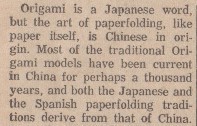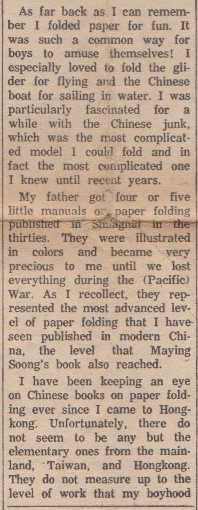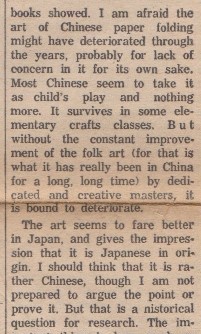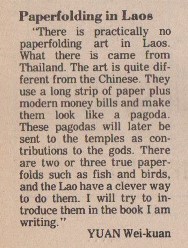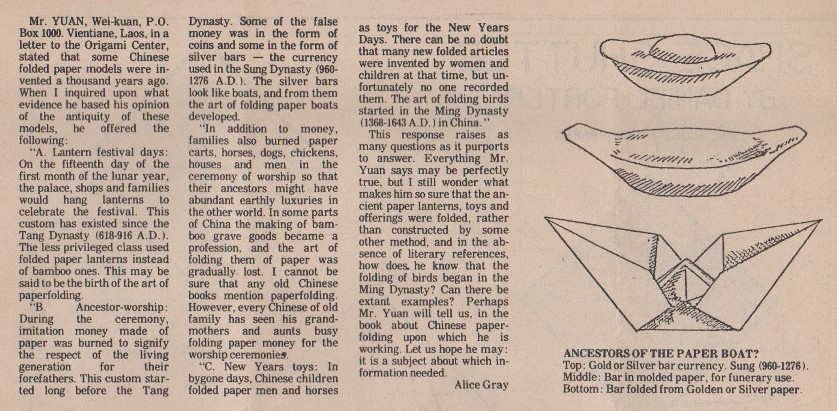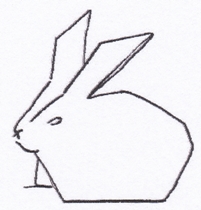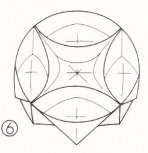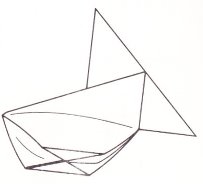| The Public Paperfolding History Project
x |
|||||||
| Chinese Paperfolding - An Overview | |||||||
| This
page provides an overview of evidence relating to the
history of paperfolding within China and among the
Chinese diaspora. Japanese-style kindergarten education,
including elements of paperfolding, was imported into
China, from Japan, from 1904 onwards. This date is thus a
watershed in the history of paperfolding in China. ********** Chinese paperfolding before 1904 Very little is known about any separate tradition of paperfolding which may have existed in China prior to the advent of kindergarten education, although it is often assumed that such a tradition existed. The evidence for such a tradition is very thin compared to that available from Japan. There is no early evidence of a tradition of formal ceremonial paperfolding such as is found in Japan, nor for any kind of representational paperfolding. Such evidence as exists relates to: The use of paperfolding to facilitate symmetrical paper cuts The folding of love letters into 'double square' forms It is sometimes theorised that two other forms of paperfolding: The folding of paper into yuan bao / sycee to be burnt at funerals The folding of paper into Multiple Layer Collapsible Boxes (Zhen Xian Bao) were also practised during this period. I have not seen any evidence to substantiate this at present, but this does not mean such evidence does not exist, or that further relevant evidence may not emerge in due course. ********** Chinese paperfolding after 1904 The import of Froebelian / traditional Japanese designs According to 'Schooling for Early Childhood? The Chinese Kindergarten in its Adolescence' by Yeh Hsueh, Joseph J. Tobin and Mayumi Karasawa, published in Prospects, vol. XXXIV, no. 4, December 2004 and available online here: 'At the turn of the twentieth century in a few coastal cities, there were a handful of foreign church-run kindergartens based on Froebelian models. But China’s first organized childcare and early education programmes did not begin until 1904, when the central government formally recognized a local government-supported kindergarten called mengyangyuan in Wuchang, a major port city on the Yangtze River, later known as Wuhan. This first Chinese kindergarten in China was based on a Japanese model inspired by Froebelian principles and practices. The three Japanese women who managed this mengyangyuan introduced a Japanese curriculum, teaching materials and cultural practices, including the Japanese language. This early, colonialist version of early childhood education in China was embraced mostly by well-to-do Chinese families and had little or no impact on the overall education system (Chen, 1996). In the first decade of the twentieth century a dozen governmental and private mengyangyuan appeared in Beijing, Shanghai, Tianjin and some other cities (Chen, 1996; Zheng, 1996; Chen & Liu, 1999). But it was not until the 1920s and the 1930s that the first major kindergarten development in China caught on, when a group of Chinese educators began actively promoting progressive educational ideas from the United States.' In their paper 'Early childhood education and care in China: history, current trends and challenges', available online here (academic login required), the authors, Xiaofei Qi and Edward C. Melhuish, state that 'The first formal public kindergarten in China was built in 1903 by the then governor Duanfang in Hubei province. The kindergarten employed a Japanese headmaster and teachers and the curriculum was much influenced by the Japanese tradition. Later, in 1904, the first regulations regarding preschool education were introduced, mainly based on Japanese kindergarten regulations from 1900.' Since the first official kindergartens were set up, and regulated, on the Japanese model it is quite possible, indeed likely, that not only the original Froebelian paperfolding designs but also other popular paperfolding designs of Japanese origin would have been taught in Chinese kindergartens and imported into Chinese culture in this way. Certainly the best known Chinese paperfolding manual for the kindergarten, 'Zhe zhi tu shuo' by Gui Shaolie, which was published in Shanghai in 1914, contains just such a mix of designs of Western and European origin as would be expected if this were true. ********** Golden Venture Origami / 3D Modular Origami More detailed information about this type of design will be added in due course. ********** Theories of a Chinese origin for paperfolding 1965 Philip Shen, a paperfolder of Chinese descent, who was born in Manila in the Phillipines but subsequently studied in Chicago then taught in Hong Kong believed that paperfolding had a Chinese origin. For instance Vol 5: Issue 2 of 'The Origamian' or Summer 1965 contains a profile of Philip Shen, written by Alice Gray, which opens with the following paragraph. No evidence is given to back up the assertions made.
The same issue contains an article 'Paper Folding as a Folk and Creative Art', written by Philip Shen, which also contains some background information on paperfolding in China..
********** 1979 The Origamian Vol 14 Issue 1-2, published in 1979, included a letter to the Editor from Yuan Wei-kuan which is headed 'Paperfolding in Laos' but is in fact largely about paperfolding in China. The information given is unfortunately not backed up by any kind of documentary evidence.
********** Designs of apparent Chinese origin discovered in the modern origami era There are several now well-known origami designs which were discovered / first published in a Chinese context. These may be considered to provide some evidence of an independent paperfolding tradition in post 1904 China. As far as I know however, there is no evidence for the existence of any of these designs prior to the dates given below. 1948 This design first occurs in 'The Art of Chinese Paper folding for Young and Old' by Maying Soong, which was published by Harcourt Brace and Company of New York in 1948.
********** 1963 This design first appears in 'The Best of Origami: New Models by Contemporary Folders' by Samuel Randlett, which was published by E P Dutton in New York in 1963 and by Faber and Faber Ltd in London in 1964, where the text says:.
********** Verdi's Vase ********** 1974 This design first appears in Issue 23 of the periodical 'The Flapping Bird' which was published in 1974, where it is just called 'The Goldfish'. The text notes that this design was discovered by Philip Shen 'in the pages of the Hong Kong periodical 'Children's Paradise' but does not give a date for this discovery.
********** The Shanghai Star and Basket *********** The Drinking Bird ********** |
|||||||
